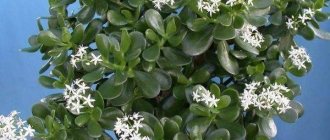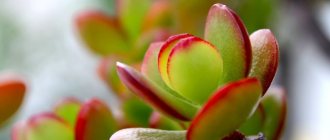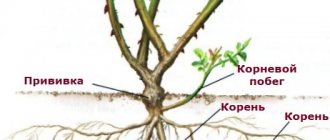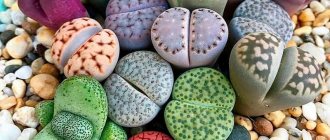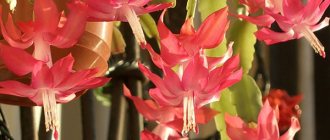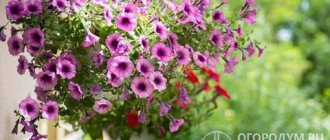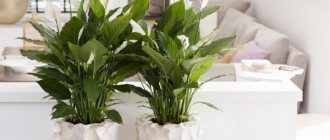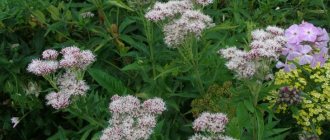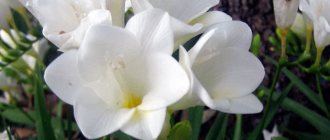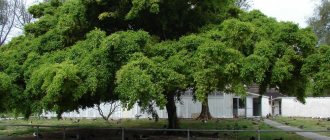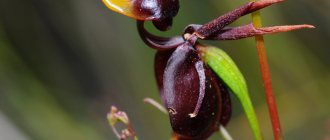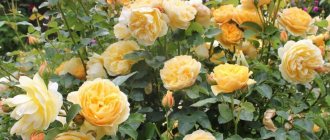Crassula ovata The Hobbit
The extensive Crassula family was replenished with a new variety of Crassula Hobbit in the middle of the last century. The flower is attractive not only for its ease of care, but also for its unusual appearance.
Crassula the Hobbit - an unusual succulent
Description
The peculiarity of the plant is the unusual shape of the leaves. Unlike ordinary Crassula, they are not round, but elongated. The edge of the leaf plate resembles a funnel, which is framed by a thin reddish border.
The shape of the flower resembles a small tree with fleshy and powerful stems and lush green leaves. In older specimens, the trunk may become partially woody. Crassula flowers are inconspicuous, small and have a pale pink tint. In indoor conditions they appear very rarely.
Origin story
Crassula Hobbit (crassula ovata hobbit) appeared thanks to the work of American breeders in the 70s of the last century. By crossing the Ovata and Molochnaya varieties, it was possible to obtain a new interesting species. The flower received its name due to the publication of Tolkien’s work “The Lord of the Rings”.
During the crossing experiment, another species was obtained - Crassula gollum. Externally, the plants are similar, but their leaf shapes are different. Crassula Hobbit has funnel-shaped leaves, fused only at the base, while Crassula Gollum has leaves fused along the entire length and widened towards the edge. There is an even later species that is similar in appearance to both of the above - Crassula Coral.
Crassula Gollum is very similar to the Hobbit variety
Description and characteristics of the species
Crassula Ovata is the most common species in indoor floriculture; it, and also Crassula Tree-like, are called money trees. As for a succulent, it grows relatively quickly, in a potted culture it reaches a maximum of 1.5 m. The trunk is succulent, thick, branches from the base, and becomes lignified over time.
The leaves are opposite, appear in pairs, each next is located crosswise to the previous one, at an angle of 45°. The plates are wedge-shaped, the base tapers, the apex is rounded. In good light, a red edge appears along the edge of the leaf.
Small white star-shaped flowers with a pinkish tint rarely appear at home; the seeds do not ripen. The root system is fibrous and underdeveloped.
Crassula variety Ovata Hobbit
It is a succulent with a thick succulent trunk and fleshy, rolled leaves. It grows at an average speed; without pruning, adult specimens reach 60-80 cm.
Hobbit plates are juicy, fleshy, elongated, up to 4 cm long, and come in two types:
- turned outward, fused at the base or to the middle of the leaf;
- similar sticks with a funnel at the end.
The color is bright green; in good lighting, a burgundy edging appears along the edge. The flower has a rare variegated form painted with white strokes.
The better the care, the more leaves take on the appearance of a rolled up bag. If the pot is in partial shade, many will become like thick sticks, even the funnels at the tips may disappear.
The Crassula Hobbit succulent branches well and immediately forms a beautiful bush, as can be seen in the photo of young plants. The trunk becomes woody, the internodes are short, the root is small and fibrous.
Only mature, well-groomed, overgrown specimens bloom with proper maintenance.
How to distinguish varieties Hobbit, Gollum, Coral
These Crassulas are often confused by amateurs. But, if you look closely, the difference is clearly visible:
- The hobbit forms more “ears” that are fused no further than the middle and turn outward;
Ovata Gollum
- Gollum - the plates are rolled into sticks fused to the end, ending in a funnel-shaped extension, which is why Crassula is called “Shrek’s ears”;
Crassula Coral
- Coral - all leaves are thick, tapering or with a small indentation at the top of the stick.
What you need to know about monstrosity
Plants with an unusual shape for the species are the result of a genetic failure. In most cultures, mutated specimens often (but not always) die, while succulents continue to grow and develop.
Crassula Hobbit - a variety with monstrous leaves, lives as long as an ordinary Crassula. Possible flowering. The original form is preserved only during vegetative propagation.
Hobbit and other varieties of Crassula Ovata need to be cared for in the same way. But monstrousness implies increased sensitivity and requires a careful attitude.
Genetic “freaks” are more afraid of overfilling or overfeeding; it is better to keep them on a starvation diet. The Hobbit also tolerates shading in the depths of the room worse without additional lighting.
Home care
Crassula ovata crassula ovata - what kind of flower
Crassula the Hobbit is unpretentious, like all succulents. Even insufficient humidity, poor watering and lack of fertilizing do not prevent this plant from growing. But in order for the flower to fully develop, some requirements must still be met.
| Lighting | Lighting should be diffused, but with high daylight hours. Direct sunlight should be avoided. A little shading in winter is acceptable. |
| Temperature | In the spring and summer, the optimal temperature is +17... +20 °C. In winter, it is better to lower the values to +14... +16 °C with a difference between day and night temperatures of 2-3 °C. |
| Watering schedule | The soil should be moistened moderately and regularly, as the soil dries 2-3 cm. In winter, watering is reduced to 1-2 times a month. |
| Air humidity | Optimal humidity levels are 60-70%, but the plant feels comfortable even at lower air humidity. |
| Feeding | There is no special need for fertilizing, but as the flower grows and the soil becomes depleted, fertilizers should be periodically applied. You only need to use special compounds for succulents. |
| Soil composition | It is best to use a ready-made substrate for succulents. If the mixture is prepared independently, then the composition must contain broken brick or small expanded clay. |
| Pot size | The root system of the flower is not very developed and rather superficial. A container of small diameter and medium depth is suitable. |
Attention! Crassula tolerates short-term drought better than waterlogging, so it should not be watered too often.
Crassula Hobbit is especially suitable for beginning gardeners. Even if you don’t have much experience in growing plants, you definitely won’t have any problems with this flower.
Crassula is a very unpretentious flower
Comfortable conditions for growing at home
This variety is kept in the same way as other Crassulas (crassula).
Lighting
Crassulas love good lighting and prefer diffused light. They are best grown on the east or west side. You can also place them on windows facing south, since these succulents are able to tolerate direct rays of the sun. Under their influence, Crassula Hobbit turns the ends of its leaf tubes purple.
After winter, it is recommended to accustom the fat woman to the sun gradually, shading it during the period of greatest solar activity.
Important! For uniform development of the Crassula Hobbit crown, it is recommended to turn different sides to the sun.
On northern windows the plant will stretch out and lose its decorative appearance. It would be better for him to organize lighting there, especially in winter.
Temperature
During the growing season, the best temperature regime for Hobbit Crassula will be +20...+25°C. In winter, it is recommended to organize a period of rest with a decrease in temperatures to +8...+10°C. This mode can be achieved on an insulated balcony. Crassula can tolerate temperatures down to -2°C, but it will be better if the temperature in winter does not fall below +6°C.
If the plant remains in a heated room, it should be placed away from the radiator. If it is not possible to lower the temperature in winter, the stems of the crassula may stretch and lose leaves.
Air humidity
Crassula hobbit tolerates dry air well, and there is no need to spray it. Sometimes it is recommended to wipe the leaves from dust with a damp cloth.
Did you know? The Crassula hobbit variety was bred in the 70s of the 20th century, when John Tolkien’s book “The Lord of the Rings” was published and gained popularity, so the new variety was named after the name of the fictional race of the main character.
Features of transplantation
Considering the rather slow development of the Crassula root system, it does not need frequent replanting. It is enough to replace the soil and pot every 2-3 years.
Crassula - home care
Step by step procedure:
- The flower is watered 2-3 days before transplantation.
- The plant is removed by transferring it, holding it by the trunk.
- A drainage layer is poured onto the bottom of the container, which should occupy ¼ of its volume.
- Pour the prepared soil into the pot.
- Carefully place the plant in the center of the container.
- Fill the pot with the remaining soil and water it.
- After the soil settles, add soil to the edge of the container.
Attention! All manipulations with the flower are carried out carefully, as there is a risk of accidentally breaking off the leaves.
Although Crassula does not need frequent replanting, replacing the soil will benefit it in any case. The flower quickly takes root in the new container and begins to intensively increase its vegetative mass.
Landing
When planting Crassula "Hobbit", special attention should be paid to preparing the substrate and choosing a pot. You can pick up the soil mixture in the store
It is better to stay with a composition intended for cacti and succulents. However, you can make the substrate yourself from available components. You need to take:
- 1 part sheet soil;
- 1 part river sand;
- 1 part turf.
All components can be assembled in an environmentally safe place away from major roads and highways. It is also necessary to add a little crushed coal, zeolite and fine expanded clay to the prepared mixture. All components must first be calcined on a baking sheet in the oven - this will destroy the larvae of insect pests, as well as pathogens of fungal, viral and bacterial infections.
You should definitely put drainage at the bottom of the container; it should occupy at least a third of the pot. Usually pebbles or expanded clay are used
This is very important, since stagnation of water leads to waterlogging of the soil, and this has the most detrimental effect on the condition of the root system and leads to the shedding of leaves
The root system of Crassula is superficial, so it is better to choose a low, but wide and flat pot for the plant. It is in such a container that the fat woman will be as comfortable as possible. The diameter of the pot should approximately correspond to the size of the crown. If it is smaller, the roots will be cramped. If you take a larger pot, the Crassula will grow and develop very slowly.
The container can be made of any material, but since the flower looks very impressive and resembles a bonsai, it will look best in a ceramic or clay container. If you wish, you can even choose a special bonsai
There is also one important requirement for Crassula pots - they must have several drainage holes to remove excess moisture from the substrate
Flowering and dormancy
Crassula - types and varieties, Moss and Perforata
Crassula Hobbit blooms very rarely and inconspicuously at home. But in winter, the plant still needs a period of rest. To do this, the flower needs to create conditions for the transition and stay there until spring.
Crassula flowers are small and inconspicuous
At the end of autumn, the average daily temperature is lowered to +14... +16 °C and the frequency of watering is gradually reduced. Fertilizing stops starting in October. If the flower is on the south window at home, then in winter it is better to move it to a less lit place. With the onset of spring, they gradually switch to a standard care regimen.
Botanical description of the plant
This is a perennial succulent from the Crassula genus of the Crassulaceae family. It differs from Crassula ovate, on the basis of which it was obtained by crossing with Crassula lactiform, only in the shape of the leaves. It looks like a tree with unusual club-shaped leaves wrapped in a tube. It grows slowly and branches well, and is more compact in size than the money tree. Like many Crassula plants, the stems become woody and brown over time. In direct sunlight, the foliage takes on a crimson hue.
At home it blooms rarely, with white or pinkish flowers. At the same time, only old plants no younger than 10 years old bloom.
| Root system | Superficial |
| Stem | tree-like |
| Leaf Shape | Tubular or club-shaped |
| Leaf color | Green |
| Flower color | White or pinkish |
Reproduction
The ease of growing Crassula concerns not only care, but also reproduction. The plant takes root easily and quickly using leaf and stem cuttings. You can grow a flower from seeds, but this is a labor-intensive and time-consuming process that gardeners rarely resort to.
Cuttings are rooted directly in the soil without keeping them in water. Sometimes planting is carried out in the same pot where an adult plant grows. There is no need to create greenhouse conditions. You just need to monitor the soil moisture, but at the same time prevent it from becoming waterlogged.
Young seedlings take root quickly
Purchase and adaptation
This variety is rare and expensive. An adult plant can be bought in an online store for at least 3,000 rubles. True, more often rooted cuttings are put up for sale, which cost from 150 to 250 rubles.
Experienced flower growers advise purchasing young specimens, because they have a better chance of getting used to new conditions.
Adaptation after purchase is necessary.
- Firstly, this is a very capricious flower that does not tolerate changing stops.
- Secondly, insect pests like to hide in its curled leaves. If you immediately place Crassula next to other house plants, it can infect them.
For the first 2-3 weeks, Crassula should be kept separately, in a warm and slightly shaded place without drafts.
If it was sold in a peat mixture instead of soil, it should definitely be replanted.
If everything goes well after quarantine, she will be placed in a permanent place.
Attention! All this time, you should carefully monitor the flower to see if the leaves turn yellow, if spots appear on them, if there are insects or traces of their vital activity in the axils.
Possible problems during cultivation
Diseases and pests rarely affect Crassula. More often, the flower suffers from improper care, especially from non-compliance with the watering regime. Excessive waterlogging of the soil can lead to the development of root and stem rot.
Attention! In addition to the watering schedule, the correct composition of the soil plays an important role - it must allow water to pass through well. When choosing a pot, you should pay attention to the presence of a sufficient number of drainage holes.
A flower can only get sick through infection from other plants. At the first signs of deterioration in appearance, you should treat the flower with special means or use traditional methods.
Crassula Hobbit is an unusual plant that does not require much attention. Caring for the flower is easy, so even a novice gardener can grow it.
What is the difference between monstrous Crassulas: Hobbit, Coral, Gollum. What leaf shape does each variety have?
All monstrous varieties of Crassula differ in the shape of their leaves. It is quite difficult for an inexperienced beginner grower to understand the differences, but they undoubtedly exist. Many people mistakenly claim that these three popular varieties differ in leaf color, trunk thickness and leaf density, but this is incorrect. All these characteristics are formed regardless of the variety. They depend primarily on proper care:
- watering (irrigation frequency and water quality);
- lighting;
- temperature regime;
- fertilizers;
- appropriate pot size.
You can read about how to properly care (how to water, what to fertilize) Crassula (Money tree) so that varietal characteristics appear HERE .
So what are the differences?
Let's look at each type of money tree in more detail.
The difference between this Succulent and Gollum
To understand why people are confused about the names of the varieties of these Crassulas, just look at the photos of these plants. They have a similar appearance: a tubular shrub-like appearance and a similar size. But it's not that complicated, just look at the tips of the leaves.
The tips of Gollum's leaves look like suction cups. Photo used as illustration. Source: Yandex.Images
Gollum's leaves end in a round sucker, reminding us of the character from the book The Lord of the Rings. The Hobbit's greens are curled back and have a fleshier, open, spoon-shaped shape.
Diseases and pests
Throughout the year, the money tree can be damaged by various infections and parasites.
| Diseases and pests | Signs | Treatment methods | Prevention |
| Powdery mildew | Appears when there is high air humidity or an excess of nitrogenous fertilizers in the soil. Appears as a whitish coating on leaves and stems | Remove all damaged organs, then treat the crown and soil with a fungicide - Topaz, Previkur or Fundazol | Control the humidity level, feed with phosphorus-potassium preparations with a small dose of nitrogen |
| Sooty mushroom | Precursors to the development of sores can be pests, high humidity or poor ventilation | All damaged areas are removed, the stems and leaves are wiped with a cotton pad soaked in a soap solution. After this, spray with Aktara | Regularly ventilate the room, control the humidity level, conduct periodic inspections for the presence of aphids, mealybugs and scale insects |
| Gray rot | It appears for several reasons - the presence of pests, frequent overflows, excess fertilizer and high humidity in the room. It affects internodes, leaves, the central stem and adjacent branches, covering them with a gray coating. Over time, it becomes watery, the flower begins to rot | All infected parts are cut out, then the crown is treated with Teldor. Transplant into a new pot with fresh substrate | Adjust the watering scheme, normalize the humidity level and periodically inspect the flower for pests |
| Anthracnose | Frequent overflow, high humidity | Treat the crown with Previkur, Skor or Fundazol | Adjust watering, control humidity |
| Root and stem rot | Knocked down and heavy soil, often waterlogged. The crown begins to fade, sheds its leaves, turns yellow at the bottom | Remove the flower from the pot, place it in a basin of water to wash off the remaining soil, dry it, and cut out all rotten areas. Sprinkle the cut areas with charcoal. After 2 hours, transplant into a clean container with a sterile substrate. | |
| Spider mite | Appears in dry air and high temperatures. It envelops the underside of leaves, internodes, and sucks juices from tissues. Affected areas become brownish in color, die, Crassula stops growing | Destroy all damaged organs. For minor damage, you can use a highly concentrated soap solution. Neglected flowers are treated with Actellik or Aktara | For preventive purposes, it is necessary to maintain moderate humidity and temperature in the room. |
| Shchitovka | Small reddish plaques stick to the stems and leaves and suck out the juices from them. In areas of parasitism, the plant turns yellow, then turns brown. | Insects are removed with a cotton pad soaked in a soap solution. Then double treatment with Decis is carried out with an interval of 7 days. | Follow the watering schedule, periodically loosen the soil, ventilate the room and maintain humidity at the desired level |
| Mealybug | It parasitizes leaves, leaving white mucus. The affected areas die off, the plant grows poorly | Remove from the old container, treat the crown and root system with Phosfamide, Actellik or Aktara. Then transplanted into a new pot with a sterile substrate. | Buy healthy plants, use high-quality soil for planting and replanting, follow the rules of care |
Actions after purchase
Crassula the Hobbit is easy to transport. Therefore, when purchasing, there is no need to carefully pack the flower, but simply wrap it in paper so as not to break the leaves.
At home, Crassula Hobbit should be kept in quarantine, that is, separately from other plants, for 2 weeks . And if signs of diseases and pests appear, treat with a fungicide or acaricide. After the waiting period has expired, the succulent must be transplanted into a new nutrient substrate. Ceramic pots, which are able to evaporate excess moisture and allow air to pass through the walls, are more suitable for this culture.
Planting Crassula Coral
To grow the Coral Crassula variety, you need well-drained soil with a neutral pH. At the bottom of a clay or ceramic pot, a layer of expanded clay or crushed stone drainage no less than 2–3 cm thick is placed. The shape of the vessel should be such that the plant after planting looks stable and does not fall to one side under the weight of the fleshy above-ground part.
The soil mixture includes high-moor peat, sand and vermiculite or perlite in a ratio of 3:1:1. A commercial soil mixture for cacti or succulents is quite suitable, but experienced gardeners advise calcining it in a hot oven so as not to introduce harmful fauna. The plant is planted so that the root collar is at the level of the surface of the earthen ball, no deeper than in the old flower container.
Young Crassulas are replanted annually; at a more mature age, one transplant every 3–4 years is sufficient. During transplantation work, some gardeners practice sanitary pruning of roots to stimulate renewal of the root system.
Sometimes, in parallel with replanting, the entire plant is rejuvenated by cutting it to the stump. Such procedures have their fans and opponents, in any case, each plant owner makes a decision independently, having made a conclusion for himself whether his flower needs such dramatic changes in appearance or not.
